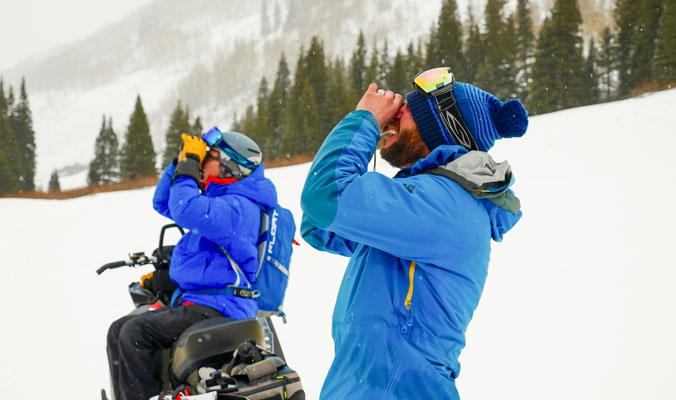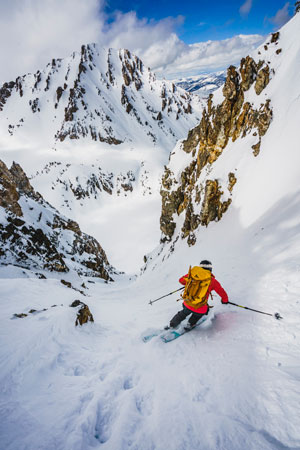
To get their boots in the door, aspiring backcountry professionals look to mentorship, observation and a season or three spent hauling gear, shadowing classes and following in the tracks of others. Is it worth it to get the dream job?
The stereotypical internship is one of corporate servitude—the white-collar serf fetching macchiatos, making copies and dying inside. An article on internships, then, seems off topic for Backcountry, like a rifle review in Good Housekeeping. But internships exist in the mountains—the gigs are just hard to find and even harder to get.
“It’s a small industry with few opportunities,” cautions Eric Murrow, 34, an aspirant forecaster who interned for Colorado’s Crested Butte Avalanche Center (CBAC) last winter. Despite being a veteran backcountry skier with a top-level avalanche certification, Murrow had been previously rejected from other internships. He was about to join ski patrol—a common track to gaining relevant experience—when Ben Pritchett, Murrow’s recent avalanche-course instructor, became CBAC’s director and reached out about an internship. Murrow subsequently spent his winter shadowing forecasters, digging pits, writing weekly summaries and filming videos.

“The stars aligned,” he says, grateful for Pritchett’s mentorship. “He made sure there was room for me to be with him out in the field, digging alongside of him, mirroring what he was doing, making assessments in a pit just adjacent.” To Murrow, the internship filled a “blind spot” in his professional skill set, as there’s some knowledge, he says, “that you just don’t get from education or by skiing on your own.”
Meanwhile, Lani Bruntz, 29, was a snowball’s toss away, interning with Crested Butte’s Irwin Guides and Eleven Experience. Bruntz’s dance with professional ski guiding began in 2012, when she enrolled in an avalanche course with Idaho’s Sawtooth Mountain Guides (SMG) and met guides and co-owners Sara and Chris Lundy. The Lundys, taken by Bruntz’s sharp eye and good nature, promptly took her under their collective wing. Though she never participated in the SMG internship program, she studied, portered, tail-guided and toured with the Lundys for two winters.
“I’ll never forget, Erik Leidecker, he’s one of the owners,” she says, “we were having a talk one night at the hut, and he was like, ‘It’s just like climbing. You can’t get into trad climbing without having someone show you the way.’” His emphasis on mentors “resonated,” she says. “From there on out, I was trying to find them.” Lani drifted away from skiing to pursue a career in the mountain bike industry, but she couldn’t shake the winter’s magnetic draw. Eventually, those Sawtooth epiphanies motivated her to relocate to Crested Butte in fall 2018 for an internship for which, on paper perhaps, she was too old and too qualified. “The opportunity to glean as much information about snowpack, forecasting, winter travel and guiding was not worth passing up for the stigma of being a 28-year-old intern,” she says.

Aside from occasional office work and shoveling sessions, Bruntz spent her internship shadowing Irwin’s avalanche classes and tours or working Eleven’s cat operation. On a typical cat day, she’d take measurements at a snow-study plot and sit in on the guide meeting. She’d then either shadow the snow-safety team—assessing snowpack, triggering controlled slides, etc.—or join guides and clients on the cat. Billy Rankin, the operation’s risk manager and snow-safety director, praised Bruntz’s conversation skills as much as her skiing ability. “That’s really what every guide service is looking for,” he says. “Solid personality, mature, able to sit and talk with guests.”
Historically, Eleven has hired interns, and Bruntz’s fingers were crossed at the end of her internship. “She’s phenomenal, and we’d love to bring her on next year,” a torn Rankin said last spring. Hiring new guides, however, isn’t cut and dry—turnover is low, work depends on storm totals, and Rankin can’t justify a new hire if it might jeopardize the livelihoods of longtime employees. At SMG, Chris Lundy is upfront with his interns—no guarantees; an internship isn’t a job interview. Still, he and Rankin agree: an intern should leave with the experience to pursue a job elsewhere. Although unable to hire last year’s intern, Lundy was pleased with how it shook out. “He got a lot of experience, some mentorship,” he says. “Then he moved on and ended up getting an assistant guide role in the Cascades.”
Dale Remsberg, an internationally certified guide and the technical director for the American Mountain Guides Association (AMGA), suggests that internships should serve as more of a backstage pass. “I don’t want people to be exploited for doing the work that they should be paid for,” he says carefully. “But I think in the outdoor industry, in the guiding world specifically, [an internship] is really a mechanism for young people to get a view in.”

For an established professional like Remsberg, it’s crystal clear: interns who perform the work of guides should be compensated accordingly. The issue of payment is notably more opaque from the perspective of operations that offer mentorship in exchange for labor. SMG’s interns , for instance, are compensated for maintaining huts and portering loads, but not for the perks of sitting in on avalanche classes and shadowing guides. Irwin interns receive housing and a stipend—compensation that’s prodigious by backcountry internship standards yet paltry in the big picture—but Rankin points out that “offering internships isn’t easy for the organization.” It’s an admittedly imperfect science from a managerial standpoint, and compensation needs to reflect the intern’s workload minus the value of shadowing professionals and the strain an internship can put on paid staff. Of course, to aspiring guides desperate for experience, dollars might seem peripheral.
You won’t hear Eric Murrow or Lani Bruntz gripe about their stipends. Nor will you hear Jack Klim, 25, grouse about his unpaid internship with Kling Mountain Guides (KMG) in Silverton, Colo. He’d already completed three internships in the outdoor space, including a formative summer position with the Colorado Outward Bound School, by the time he linked up with KMG. A humble hard worker, Klim busted tail and bartended to make ends meet. “I’d go to work at 5 p.m., work ’til 2 a.m., wake up at 6 a.m., shadow an avalanche course until 4 p.m. and then go back to work at 5 p.m.,” he chuckles. “It was just training for all the alpine starts I do now.”
The payoff? Klim worked directly with owner Josh Kling, an influential mentor, in addition to shadowing several internationally certified mountain guides. “That was a really great experience,” he says. Klim assisted with a staggering 12-to-14 avalanche courses throughout his internship; sleep deprivation notwithstanding, when it came time to take his Instructor Training Course, he could teach an avalanche class with his eyes closed.
Izzy Lazarus, 25, also got her start through an internship at Outward Bound, where, she says, mentorship was built into life. “There’s all these instructors who have worked there for three, five, 10 years,” she says. “And it’s like, ‘OK, who do I get along with? Maybe I can learn something from them.’”
Being surrounded by professionals inspired Lazarus to continue pursuing AMGA certifications, but it also helped her recognize that there are some skills that no amount of coursework—or streaming—will teach. “I can’t go and watch a YouTube video and become a ski guide,” she jokes. “I need to be out in the field with clients.” Sacrificing time and money for the right internship, then, seems sensible to Lazarus, so long as the compensation is fair—meaning transferrable skills and, in an ideal world, transferrable funds.
As turning aspens cloaked Crested Butte in gold this fall, a spot opened up for Murrow on the CBAC forecasting team. After a summer of uncertainty, Bruntz got word that she’d officially joined the Irwin roster. Klim’s dues were paid, his unpaid winters over—Kling brought him on as a ski guide and instructor. Lazarus went from intern to instructor at Outward Bound, then locked down a summer job with Jackson Hole Mountain Guides that she recently turned into a winter role.
Not everyone is so lucky.
There are few guide jobs and fewer internships across North America. Prospective backcountry professionals sometimes wallow in what SMG’s Lundy calls, “no-man’s land,” a purgatory populated by educated, certified candidates who don’t have enough experience to get a legitimate job. Remsberg, an instructor and mentor to countless up-and-comers, suggests luck is inconsequential. “The people that are hungry find those internships,” he says simply. “And they usually turn ’em into positions at some point.”










Related posts:
Margaret Wheeler: America’s Second Female IFMGA Guide
The Skills Guide: Four Steps to Know Thy Self
How one Crested Butte-based skier pays it forward
Deep Threads: Eight essentials for powder-day touring